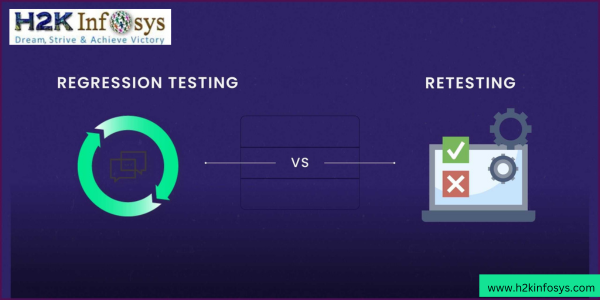Introduction
Software testing plays a crucial role in ensuring the quality and reliability of software applications. With the increasing complexity of modern software, companies must adopt robust testing strategies to ensure bug-free releases. Regression and Retesting are two essential testing techniques that help maintain software integrity and enhance the overall user experience and trust in the product.
Among various testing methodologies, regression testing and retesting are two fundamental techniques that often cause confusion among new testers. While both are vital for maintaining software integrity, they serve different purposes in the software development lifecycle (SDLC). Understanding their differences is essential for aspiring Quality Assurance Testers, as it helps them apply the right testing method at the right stage of development.
Regression and Retesting play significant roles in agile and DevOps environments, where continuous integration and deployment occur frequently. Regression testing ensures that recent code changes do not negatively impact existing functionalities, while retesting focuses on verifying whether identified defects have been successfully fixed. Both are indispensable for ensuring smooth software performance.
If you are considering a career in software quality assurance, mastering Regression and Retesting techniques is essential. This article will provide an in-depth comparison of these testing methods, highlight their importance, and present real-world examples to illustrate their applications. By the end of this guide, you will be well-equipped to apply Regression and Retesting effectively in your QA career.

What is Regression Testing?
Definition: Regression testing is a type of software testing performed to verify that new changes, such as bug fixes, enhancements, or updates, have not adversely affected the existing functionalities of an application.
Key Features of Regression Testing:
- Ensures that recent code changes do not introduce new defects.
- Involves retesting previously working functionalities.
- Automated test scripts are commonly used for efficiency.
- Performed after modifications like bug fixes, updates, or integrations.
- Covers a broader test scope to ensure overall system stability.
Once the application code is modified (for example after fixing a defect or some enhancement is done), we need to test and ensure the existing functionalities are working fine. This is called regression testing. For example if a new text box is added to a web page. Then we have to ensure the look and feel is not disturbed after introducing the text box also other fields which were already there in the page is working as expected. This is called regression testing.
Why is Regression Testing Important?
- Prevents Bug Reintroduction: A small code change can affect multiple parts of an application.
- Enhances Software Reliability: Ensures that updates do not break existing functionalities.
- Saves Cost and Time: Early detection of issues prevents expensive rework.
- Automatable for Efficiency: Regression testing is often automated using tools like Selenium, TestNG, or JUnit.
Real-World Example of Regression Testing
Imagine a Banking application where the development team updates the login module to improve security. Regression testing ensures that while enhancing the login mechanism, features such as fund transfers, bill payments, and user dashboard functionalities remain unaffected.
Types of Regression Testing
- Unit Regression Testing: Focuses on testing individual modules after modifications.
- Partial Regression Testing: Ensures that new changes do not disrupt dependent functionalities.
- Complete Regression Testing: Conducted after major updates to verify the entire application.
What is Retesting?
Definition: Retesting is a testing process conducted to verify that specific defects identified in previous testing phases have been successfully fixed.
Key Features of Retesting:
- Focuses only on failed test cases that have been fixed.
- Performed after the developer resolves the reported bugs.
- Involves executing the same test cases where defects were found.
- Usually done manually to ensure precise verification.
- Not automated because it involves testing new fixes.
Why is Retesting Important?
- Confirms Bug Fixes: Ensures that reported defects are resolved without any further issues.
- Verifies Expected Functionality: Checks that the applied fixes work correctly.
- Prevents Recurrence of Bugs: Helps to ensure that fixed bugs do not reappear in future versions.
Real-World Example of Retesting
Consider an e-commerce website where users faced an issue with the checkout process due to a discount code error. After developers fix the bug, retesting ensures that applying discount codes now works as expected.
after regression and retestingregression and retesting a defect is found by testers and then it will be fixed by developers, it is again tested to confirm that the original defect is actually fixed. Retesting is done to make sure that the test cases which were failed earlier due to some defect is now passing after the defect is fixed.
When Should Retesting Be Performed?
- After developers have fixed reported bugs.
- When patches or hotfixes are applied to the software.
- In scenarios where specific functionalities were previously broken.
Key Differences Between Regression Testing and Retesting
| Aspect | Regression Testing | Retesting |
|---|---|---|
| Purpose | Ensures new changes do not impact existing functionalities | Verifies that previously reported defects have been fixed |
| Scope | Covers multiple functionalities | Limited to specific failed test cases |
| Test Cases | Includes both old and new test cases | Only the previously failed test cases |
| Automation | Often automated for efficiency | Mostly manual for precise verification |
| Execution Time | Takes longer due to wider test coverage | Relatively quicker since it focuses on specific areas |
| Example | Checking if adding a new feature affects existing modules | Checking if a fixed checkout issue now works |
How Are Regression Testing and Retesting Used Together?
Both regression and retesting complement each other in the software testing lifecycle. When a bug is reported, developers fix it, and testers conduct retesting to confirm the fix. regression and retesting After that, regression testing is performed to ensure that the fix has not negatively affected other functionalities.
For example, in an online banking application:
- A bug is identified in the loan application module.
- Developers fix the issue.
- Testers perform retesting to validate the fix.
- Testers conduct regression testing to check that related modules (e.g., loan calculations, EMIs) work correctly.
Best Practices for Regression Testing and Retesting
Regression Testing Best Practices:
- Automate repetitive test cases using Selenium, JUnit, or TestNG.
- Maintain a regression test suite for different application versions.
- Prioritize test cases based on critical functionalities.
- Execute regression tests after every major change.
Retesting Best Practices:
- Focus only on failed test cases.
- Use real-world scenarios for effective validation.
- Perform manual testing to confirm precise bug fixes.
- Document every bug fix and its resolution for future reference.
Tools for Regression Testing and Retesting
Popular Regression Testing Tools:
- Selenium (Automated UI Testing)
- TestNG (Java-Based Testing Framework)
- JUnit (Unit Testing for Java)
- Appium (Mobile Automation Testing)
- Cucumber (Behavior-Driven Testing)
Popular Retesting Approaches:
- Manual Execution (Performed by testers without automation)
- Test Case Prioritization (Testing high-priority defects first)
- Exploratory Testing (Validating bug fixes in a dynamic way)
Why Should You Learn Regression Testing and Retesting?
As a QA tester, mastering regression and retesting enhances your ability to ensure software quality. Companies look for professionals skilled in these techniques because they:
- Reduce software failures and bugs.
- Improve application stability and performance.
- Help businesses deliver high-quality products.
If you want regression and retesting to build a career in software testing and quality assurance, enrolling in a QA testing online training course will equip you with the necessary hands-on skills.
Conclusion
Understanding the difference between regression and retesting is crucial for every software tester. While regression and retesting ensures that new updates do not disrupt existing functionalities, retesting verifies that fixed defects no longer persist. Both play essential roles in quality assurance and help in delivering stable software applications.
Do you want to master software testing? Enroll in H2K Infosys’ Quality Assurance Tester Course today and gain hands-on experience in regression and retesting and automation testing!






















